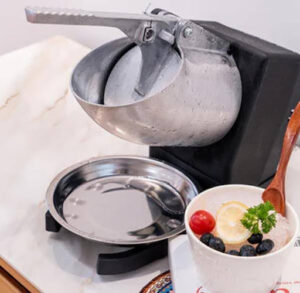TOPIC
How to Choose the Best Shaved Ice Maker for Your Home

If you enjoy refreshing icy treats at home, a shaved ice maker can be a great addition to your kitchen. Choosing the right one, however, involves considering various factors, from the type of machine to the features that suit your lifestyle. With so many options available, it’s important to know what to look for in a quality shaved ice maker. This guide will help you understand the different types of shaved ice makers, key features to consider, and tips on selecting the best model for your needs. Additionally, you’ll find a top recommendation to get you started on your search. Let’s dive in and find the perfect shaved ice maker for your home, so you can enjoy delicious, refreshing treats like Hawaiian shave ice or learn how to make japanese shaved ice with ease.

What Types of Shaved Ice Makers Are Available?
Understanding the types of shaved ice makers is the first step to making an informed decision. Here’s a breakdown of the main options.
Manual Shaved Ice Makers
Manual shaved ice makers are simple and easy to use. They require physical effort to operate, as you manually turn a handle or press down on a lever to shave the ice. These machines are generally compact and affordable, making them an excellent choice for occasional use. They don’t require electricity, which makes them portable and ideal for outdoor events like picnics or camping. The texture of the shaved ice may vary depending on the specific model, but many manual options allow you to adjust the thickness for a customized result. Though they may not produce large quantities quickly, manual shaved ice makers are budget-friendly and can be a fun, hands-on way to create icy treats, especially if you’re experimenting with recipes like how to make Japanese shaved ice.
Electric Shaved Ice Machines
Electric shaved ice machines are a popular choice for their ease of use and speed. With just the press of a button, these machines can quickly produce fine, fluffy ice without any physical effort. They’re ideal for frequent use or for serving multiple people, as they typically have a higher capacity than manual models. Electric machines come with various features like adjustable blades, which allow users to control the texture of the ice. This makes it easy to experiment with different shaved ice styles, from classic snow cones to finely shaved ice perfect for learning how to make Japanese shaved ice at home.
Commercial-Grade Shaved Ice Makers
Commercial-grade shaved ice makers are designed for high-volume use and are commonly found in restaurants, cafes, or food stalls. They are built to be durable, with heavy-duty materials like stainless steel and high-power motors. These machines can handle large quantities of ice and produce consistently fine and fluffy ice, perfect for businesses or households that entertain frequently. They tend to be larger in size and more expensive, but their performance and longevity justify the cost for high-demand situations. If you’re considering a commercial-grade option for your home, ensure you have adequate space and the need for such a high-capacity machine, especially if you plan to make a variety of treats, like Japanese shaved ice, on a regular basis.
Key Features to Consider When Buying a Shaved Ice Maker
To select the best shaved ice maker, it’s crucial to evaluate specific features that impact performance and convenience.
Ice Texture and Consistency
The texture and consistency of shaved ice are vital for creating the perfect treat. Some machines allow you to adjust the ice texture from coarse to fine, which is helpful if you enjoy different types of shaved ice treats. For example, Hawaiian shave ice is known for its fluffy, snow-like consistency, while other styles may require a chunkier texture. Electric models often provide better consistency, as their adjustable blades ensure each ice shaving is uniform. For fans of Asian desserts, knowing how to make Japanese shaved ice, also known as “kakigori,” is easier with a machine that allows fine texture adjustments for a soft, delicate ice.
Capacity and Size
The machine’s capacity and size should match your usage needs. Smaller machines are ideal for personal use or small families, while larger models can cater to gatherings and parties. Capacity is also linked to the amount of counter or storage space you have available. If you’re limited on space, consider a compact model that’s easy to store when not in use. Conversely, if you frequently entertain or have a large family, opt for a model with a higher ice-holding capacity to avoid refilling frequently, especially if you plan to make treats like Japanese shaved ice for guests.
Ease of Use and Cleaning
A user-friendly design can make a significant difference in your experience with a shaved ice maker. Look for features like simple controls, ergonomic handles, and easy assembly. Machines with removable parts are typically easier to clean, saving you time and effort. Cleaning is particularly important to prevent the buildup of bacteria, especially if you use flavored syrups. Some models are dishwasher-safe, which further simplifies maintenance. If you’re exploring recipes on how to make Japanese shaved ice, consider a model that’s easy to disassemble, as it will help keep your machine hygienic and ready for frequent use.
Durability and Build Quality
Investing in a durable machine ensures you’ll enjoy shaved ice for years to come. Look for models made from high-quality materials like stainless steel or BPA-free plastics. Durability is especially crucial for high-frequency use or if you plan to use your machine outdoors. The SCHWUA Freestanding Shaved Ice Machine, for example, is crafted from robust 304 stainless steel and eco-friendly plastics, providing both strength and a lower environmental impact. Its reliable construction is perfect for frequent use, especially if you’re interested in how to make Japanese shaved ice regularly or experimenting with other frozen treats.
How Do You Determine the Right Shaved Ice Maker for Your Needs?
To choose the best machine, consider how it aligns with your lifestyle and needs.
Frequency of Use
If you plan to use the shaved ice maker regularly, investing in a durable electric or commercial-grade model may be worthwhile. Frequent users benefit from features like higher capacity, faster operation, and adjustable texture options. If you’re experimenting with how to make Japanese shaved ice, which involves very fine, fluffy shavings, look for a model that can produce consistent results at the texture you desire.
Budget Considerations
Budget plays a significant role in your decision. Manual shaved ice makers are generally the most affordable, while electric and commercial-grade machines come at a higher price. Identify your budget range and prioritize features accordingly. High-quality materials and additional features, such as adjustable blades, can drive up the price but may provide long-term value. Investing a bit more in a machine that can handle recipes like Japanese shaved ice might be a smart choice for enthusiasts.
Space Constraints
Space can limit your choices. If counter or storage space is scarce, opt for a compact model. Some machines are specifically designed for small spaces without sacrificing functionality. Ensure the dimensions fit your kitchen setup, so the machine is convenient to access and use whenever the craving for shaved ice hits, especially if you’re learning how to make Japanese shaved ice in the comfort of your home.
Top Shaved Ice Maker Recommendation
A standout choice in the market is the SCHWUA Freestanding Shaved Ice Machine in 304 Stainless Steel with 2 Blades. This model is well-suited for home use, offering high-quality construction and practical features. Its durable stainless steel blades ensure a consistent shave, while the eco-friendly plastic body makes it lightweight and portable. This machine can crush up to 65kg of ice per hour, making it efficient for large batches of shaved ice, including delicate, fluffy textures ideal for Japanese shaved ice.

Designed with user convenience in mind, the SCHWUA has an easy-to-operate button on the bottom and a firm handle grip for stability. The adjustable blade gap allows you to customize the ice texture to your liking, from coarse to fine, making it versatile enough for a variety of frozen treats. Its compact design and eco-conscious materials make it an ideal choice for environmentally-minded individuals who value durability and efficiency in their kitchen appliances.
Conclusion
Choosing the right shaved ice maker can transform your home treat-making experience. By considering the types of machines, key features, and how often you’ll use the device, you can make an informed decision that fits your lifestyle and preferences. Whether you opt for a manual model or a high-performance electric option, a shaved ice maker can bring refreshing, icy delights to your home year-round. The SCHWUA Freestanding Shaved Ice Machine, with its durable stainless steel design and impressive ice-shaving capacity, is an excellent choice for those who prioritize quality and convenience. With the right shaved ice maker, you’ll be well-equipped to enjoy a variety of frozen treats, from classic snow cones to learning how to make Japanese shaved ice, a delicate dessert that’s perfect for warm days.
TOPIC
The Rise of Anonibs: A New Era for Anonymous Voices on the Internet

Introduction to Anonibs and their purpose
In a digital landscape cluttered with curated personas and highlight reels, the emergence of anonibs is shaking things up. These anonymous platforms are carving out a unique space for voices that might otherwise be drowned out by the noise of traditional social media. Picture this: sharing your thoughts without fear of judgment or repercussions. Anonibs allow anyone to express their opinions freely, embracing authenticity in an often superficial online world.
But what exactly are anonibs? They represent more than just another trend; they embody a new era where anonymity meets freedom of speech. As we delve into the rise of these platforms, we’ll explore their purpose, history, and potential impact on our digital interactions. This journey promises to uncover how anonibs could redefine communication as we know it while providing insight into the complexities surrounding them. Get ready to discover how anonymous voices are finding their place—and making waves—online!
History of anonymous online platforms
The journey of anonymous online platforms begins in the early days of the internet. Forums and chat rooms allowed users to engage without revealing their identities. This fostered a sense of community, where people could share ideas freely.
As social media emerged, anonymity took on new forms. Websites like 4chan and Reddit offered spaces for unfiltered expression. Users found solace in sharing thoughts that might be too controversial or personal under their real names.
While some embraced these platforms for genuine connection, others used them for less noble purposes. The dark web became synonymous with anonymity as it provided both privacy and illicit activities.
Over time, the conversation around digital identity evolved significantly. Anonymity is now seen as a double-edged sword—crucial for free speech but also challenging to regulate effectively amidst rising concerns about cyberbullying and misinformation.
The benefits of Anonibs for users
Anonibs offer users a unique space to express themselves without the fear of judgment. This anonymity fosters open dialogue, allowing individuals to share thoughts on sensitive topics freely.
With no real names attached, people can voice opinions that might otherwise remain silent due to societal pressures. This liberation encourages diverse viewpoints and richer discussions.
Additionally, Anonibs create a sense of community among like-minded individuals. Users often find solace in knowing others share their experiences or beliefs, leading to supportive interactions.
The platform also empowers those who may feel marginalized in traditional social media settings. Voices that are often overlooked gain traction here, promoting inclusivity and understanding across different demographics.
Moreover, this anonymity can spark creativity. Freed from personal identities, users explore ideas more boldly than they would elsewhere.
How Anonibs protect user privacy and freedom of speech
Anonibs are designed with user privacy at their core. By allowing individuals to share thoughts without revealing identities, these platforms create a safe space for expression.
Users can voice opinions on sensitive subjects without fear of backlash. This level of anonymity encourages open dialogue and fosters diverse perspectives that might otherwise remain unheard.
Moreover, Anonibs implement robust encryption methods. These technologies safeguard personal data from prying eyes, making it difficult for external forces to invade users’ digital lives.
In an era where free speech faces increasing scrutiny, platforms like Anonibs offer a valuable refuge. They champion the right to speak freely while ensuring those voices remain protected in an often hostile online landscape.
By prioritizing confidentiality and safeguarding against censorship, Anonibs empower users to explore ideas without limitations or repercussions.
The impact of Anonibs on traditional social media platforms
Anonibs are reshaping the landscape of online communication. By offering a space where anonymity reigns, they provide an alternative to traditional social media platforms that often prioritize identity disclosure.
Users flock to Anonibs for freedom from judgment and scrutiny. This shift challenges established norms on platforms like Facebook and Twitter, where personal branding is key. The allure of unfiltered conversations draws many away from carefully curated feeds.
As engagement increases on Anonibs, traditional sites face pressure to adapt. They may need to rethink their approaches to privacy and user interaction. Some might even consider integrating anonymous features in response.
This evolution poses questions about content moderation and community standards as well. Can these old guard platforms maintain control when faced with the rise of voices that prefer not to be tied to a real name? The dynamics between anonymity and accountability remain at play in this new environment.
Controversies surrounding Anonibs
Anonibs have sparked a range of controversies since their emergence. Critics argue that anonymity can lead to irresponsible behavior, including harassment and hate speech. Without accountability, some users may feel empowered to share harmful content.
Additionally, the lack of transparency surrounding moderation practices raises concerns. Questions about how platforms enforce rules or manage abusive content linger in discussions among users and stakeholders alike.
Another angle involves the potential for misinformation. With anonymous voices proliferating on these platforms, it becomes challenging to discern fact from fiction. This has implications not just for individuals but society as a whole.
Yet, supporters highlight that these issues also exist on traditional social media sites. They believe Anonibs provide an alternative space where marginalized voices can speak freely without fear of reprisal or censorship. The debate continues as advocates push back against criticisms while addressing valid concerns raised by opponents.
Future developments and potential challenges for Anonibs
The future of Anonibs is filled with promise and complexity. As technology evolves, these platforms may adopt advanced encryption methods to further safeguard user identities. This could enhance trust among users seeking anonymity.
However, challenges loom on the horizon. Regulatory scrutiny is increasing globally. Governments are looking to impose stricter rules on online anonymity, aimed at combating cybercrime and misinformation.
Maintaining a balance between privacy rights and accountability will be critical for Anonibs going forward. They must navigate the fine line between protecting free speech and ensuring that harmful content doesn’t proliferate unchecked.
User engagement will also play a crucial role in shaping platforms’ evolution. Community-driven moderation might emerge as a solution to maintain healthy discussions while preserving the core values of anonymity.
Innovation in user experience can attract new audiences but requires careful planning to avoid alienating existing ones who value their privacy deeply.
Conclusion: The potential for positive change through anonymous online platforms
The rise of anonibs marks a significant shift in how we engage online. These platforms offer users a space to express their thoughts without fear of judgment or repercussion. This anonymity can foster open discussions that might otherwise be stifled on traditional social media.
As society grapples with issues like censorship and privacy, the potential for positive change through anonymous voices is immense. Anonibs empower individuals to share their experiences and perspectives freely, creating a richer tapestry of dialogue across the internet.
While challenges remain—such as combating misinformation and ensuring respectful discourse—the promise of anonibs lies in their ability to amplify unheard voices. As these platforms continue to evolve, they may redefine our understanding of community and expression in the digital age. The future looks bright for those seeking truth and connection through anonymity.
TOPIC
Why Adsy.pw/hb5 is a Game Changer for Online Marketing

Introduction to Adsy.pw/hb5 and its Features
In the fast-paced world of online marketing, staying ahead of the curve is essential. Enter Adsy.pw/hb5—an innovative tool that promises to change the game for marketers everywhere. This platform combines cutting-edge technology with user-friendly features, making it an indispensable asset for businesses seeking growth and visibility in a crowded digital landscape.
Imagine effortlessly enhancing your marketing strategies while maximizing engagement and conversions. With Adsy.pw/hb5, this isn’t just a dream; it’s reality. Whether you’re a seasoned marketer or just starting out, this tool offers something valuable for everyone. Ready to discover how Adsy.pw/hb5 can elevate your online presence? Let’s dive into its standout features and explore why it’s generating buzz across the industry!
How Adsy.pw/hb5 is Revolutionizing Online Marketing
Adsy.pw/hb5 is changing the game in online marketing with its innovative approach. It streamlines the ad creation process, making it accessible for everyone, from novice marketers to seasoned professionals.
The platform offers a user-friendly interface that allows users to design campaigns quickly. No more complicated setups or steep learning curves. With drag-and-drop features and customizable templates, creating impactful ads becomes effortless.
Moreover, Adsy.pw/hb5 integrates advanced analytics tools. This means businesses can track their performance in real-time. Understanding audience engagement has never been easier.
Another standout feature is its extensive reach across multiple channels. Users can distribute content seamlessly on various platforms without losing consistency or quality.
With AI-driven recommendations, advertisers can optimize their strategies instantly. This adaptive capability ensures your campaigns are always relevant and effective in an ever-changing digital landscape.
Testimonials from Users and Their Success Stories
Users of adsy.pw/hb5 have shared inspiring success stories that highlight the platform’s potential. Many report significant increases in website traffic and conversions after implementing its innovative strategies.
One user, a small business owner, saw her sales double within weeks. She attributes this growth to targeted campaigns made easy by adsy.pw/hb5’s intuitive interface.
Another entrepreneur praised the analytics tools provided by the platform. These features allowed him to tweak his marketing approach effectively, leading to a more engaged audience.
A digital marketer emphasized how adsy.pw/hb5 streamlined her workflow. With automated processes and insightful data at her fingertips, she managed to save time while boosting results.
These testimonials underscore not just individual successes but also a community growing around adsy.pw/hb5 dedicated to elevating their online marketing game.
Comparison with Other Online Marketing Tools
When comparing adsy.pw/hb5 to other online marketing tools, its unique approach stands out. Many platforms rely heavily on traditional methods and outdated algorithms. In contrast, Adsy integrates innovative features that adapt to current market trends.
User-friendliness is another key aspect. While some tools can be cumbersome and complex, adsy.pw/hb5 simplifies the user experience. The intuitive design allows marketers at any level to navigate with ease.
Additionally, pricing models vary widely among competitors. Adsy offers competitive rates that cater to startups and established businesses alike, making it accessible for all users.
Performance tracking is crucial in digital marketing. Unlike many alternatives that provide limited insights, adsy.pw/hb5 delivers comprehensive analytics in real time, empowering users with actionable data for better decision-making.
This blend of efficiency and adaptability positions adsy.pw/hb5 as a top choice in a crowded marketplace filled with generic solutions.
Tips for Maximizing Results with Adsy.pw/hb5
To get the most out of Adsy.pw/hb5, focus on targeted audience segmentation. Understand who your customers are and tailor your campaigns to meet their needs effectively.
Consistent testing is key. Experiment with different ad formats and messaging styles to determine what resonates best with your audience. This will help you fine-tune your strategy over time.
Leverage analytics tools available within Adsy.pw/hb5 to track performance metrics closely. Use insights gained from these reports to make data-driven adjustments that can enhance results.
Engagement doesn’t stop at posting ads. Foster interaction by responding promptly to comments or inquiries related to your campaigns.
Keep an eye on industry trends and adapt swiftly. The digital landscape changes rapidly; staying informed allows you to optimize strategies continuously for better outcomes.
Future Updates and Developments for Adsy.pw/hb5
Adsy.pw/hb5 is on the brink of exciting new developments. The team behind it is constantly exploring innovative features to enhance user experience and effectiveness.
Upcoming updates are set to include advanced analytics tools, allowing users to gain deeper insights into their campaigns. This will empower businesses to make data-driven decisions with ease.
Integration with popular social media platforms is also in the pipeline. By streamlining these connections, marketers can amplify their reach effortlessly.
Moreover, enhanced customer support options promise quicker resolutions for any challenges faced by users. This commitment ensures that every business can maximize its potential using Adsy.pw/hb5.
Stay tuned for announcements as they roll out these game-changing enhancements!
Conclusion: Why Adsy.pw/hb5 Should Be a Part of Every Business
Adsy.pw/hb5 is not just another tool in the crowded online marketing space; it represents a shift toward smarter, more efficient strategies that cater to modern digital needs. Businesses aiming for growth can greatly benefit from its unique features and user-friendly interface. The testimonials speak volumes about real success stories where marketers have seen tangible results.
Its ability to integrate various marketing functions sets Adsy.pw/hb5 apart from traditional tools. Users appreciate how it streamlines their efforts, making campaigns more effective without unnecessary complications. By fostering better engagement and higher conversion rates, it’s clear why so many are adopting this platform.
As businesses look ahead, staying updated with future developments of Adsy.pw/hb5 will be essential for maintaining a competitive edge. This tool isn’t just about immediate gains; it’s about sustainable growth and adaptability in an ever-changing landscape.
For any business serious about enhancing its online presence and driving sales, incorporating Adsy.pw/hb5 into their strategy seems like a smart move. The insights gained from using this platform can lead to innovative approaches that resonate well with target audiences while maximizing returns on investment.
TOPIC
Exploring Noodlemag: The Ultimate Guide to Your Next Favorite Read

Introduction to Noodlemag
Welcome to the world of Noodlemag, where stories come alive and every page turns into an adventure. If you’re on the hunt for your next favorite read, look no further. This online treasure trove is dedicated to all things literature, from thought-provoking articles to insightful book reviews. Whether you’re a casual reader or a passionate bibliophile, Noodlemag has something for everyone.
Dive into diverse genres and discover fresh voices that will inspire and entertain you. With easy navigation and engaging content, exploring this literary hub is not just enjoyable; it’s essential for any book lover seeking their next obsession. Ready to embark on a reading journey like no other? Let’s explore what makes Noodlemag the ultimate destination for readers everywhere!
The History and Mission of Noodlemag
Noodlemag began as a humble platform for passionate readers and writers. Founded by a group of literature enthusiasts, it aimed to bridge the gap between authors and their audience. The idea was simple yet powerful: create a space where stories could thrive.
The mission of Noodlemag is to celebrate literature in all its forms. It seeks to highlight diverse voices that often go unheard in mainstream media. By focusing on quality content, Noodlemag champions creativity and encourages dialogue among readers.
Over the years, Noodlemag has evolved but remains true to its roots. It fosters an inclusive environment where newcomers can share their work alongside seasoned writers. This commitment to community building is at the heart of what makes Noodlemag special; every piece published contributes to a bigger narrative in the literary world.
Navigating the Website: Layout and Features
Noodlemag’s website is designed with user experience in mind. The moment you land on the homepage, a clean layout greets you. It’s easy to find what you need.
The navigation bar at the top clearly displays categories, making exploration efficient. You can quickly jump from articles to reviews or author interviews without any hassle.
Each article features eye-catching images and well-organized text blocks. This visual appeal keeps readers engaged while they browse through various topics.
On mobile devices, Noodlemag retains its functionality seamlessly. Everything adapts perfectly for users on-the-go who want their next great read at their fingertips.
Don’t overlook the search function either; it helps pinpoint specific content swiftly. Whether you’re looking for book recommendations or writing tips, this feature enhances your browsing experience significantly.
Top Categories and Genres on Noodlemag
Noodlemag is a treasure trove for readers seeking diverse genres and categories. Whether you’re into romance, science fiction, or mystery, there’s something for everyone.
One of the standout categories is contemporary literature. This section dives deep into current societal themes while showcasing emerging voices in storytelling.
Fantasy lovers will find their haven too. With tales that transport you to other worlds, it’s easy to lose track of time among dragons and daring quests.
For those who enjoy non-fiction, Noodlemag offers insightful articles covering everything from personal development to cultural critiques. Each piece invites readers to reflect on real-life experiences.
Don’t forget the young adult category! Packed with relatable characters and gripping plots, it speaks directly to both teens and adults looking for nostalgia or new perspectives.
With such a wide array of options, exploring Noodlemag’s top categories becomes an adventure in itself.
Must-Read Articles and Reviews on Noodlemag
Noodlemag is a treasure trove of insightful articles and reviews. Each piece offers readers a chance to dive deep into the world of literature.
From thought-provoking essays on contemporary themes to nostalgic reflections on classic works, there’s something for everyone. The book reviews stand out with their honest critiques and engaging narratives.
Highlighted pieces often feature emerging authors, shedding light on fresh voices that deserve attention. Readers can discover hidden gems while getting recommendations tailored to diverse tastes.
The editorial team also curates thematic round-ups throughout the year. These collections make it easy to explore specific genres or topics in depth.
Whether you’re seeking inspiration or just curious about literary trends, Noodlemag’s content does not disappoint. Each article enriches your reading experience and keeps you coming back for more insights into the literary landscape.
How to Submit Your Own Writing to Noodlemag
Submitting your writing to Noodlemag is a straightforward yet rewarding process. First, familiarize yourself with the types of content they feature. Whether it’s fiction, poetry, or essays, understanding their style will increase your chances of acceptance.
Next, prepare your manuscript according to their guidelines. Check for formatting specifics and word count limits on their submission page. Attention to detail matters here; it shows professionalism.
When you’re ready, draft a compelling cover letter. This brief introduction should highlight what makes your piece unique and why it fits with Noodlemag’s mission.
Send in your work through the designated submission portal. After that? Patience is key! Expect feedback within a few weeks but remember that quality takes time in this literary world. Your voice could soon join the vibrant tapestry that is Noodlemag’s offerings!
Exclusive Interviews with Notable Authors on Noodlemag
Noodlemag stands out for its exclusive interviews with notable authors. These conversations provide readers a rare glimpse into the minds of their favorite writers.
Authors share insights about their creative processes, inspirations, and challenges faced in the literary world. Each interview is crafted to dive deep into personal stories that resonate with fans.
Readers can get firsthand accounts of how specific experiences shape narrative choices or character developments. This behind-the-scenes look adds depth to the reading experience.
Moreover, Noodlemag’s format encourages interaction. Fans often engage through comments, asking follow-up questions or sharing their thoughts on the topics discussed.
Discovering these interviews opens up new dimensions to beloved books and offers fresh perspectives that inspire both aspiring writers and avid readers alike.
Joining the Noodle Community: Reader Interactions and Book
Joining the Noodle Community opens up a world of possibilities for every book lover. Readers can interact through comments, discussions, and forums on various articles. This creates a vibrant space where ideas flourish and recommendations abound.
The sense of community is palpable as members share their thoughts on recent reads or anticipated releases. Engaging with fellow readers not only enhances your reading experience but also provides diverse perspectives that could lead you to your next favorite book.
Noodlemag fosters an inclusive atmosphere. Book clubs often form among its readers, creating opportunities for deeper dives into literary themes and genres. Whether you’re looking for casual conversations or in-depth analyses, you’ll find it all here.
Additionally, special events like author Q&As and virtual meet-ups are regular features within the community. These occasions allow fans to connect directly with writers they admire while fostering friendships based around shared literary passions.
So dive into Noodlemag! Your journey through words awaits alongside a lively group of fellow literature enthusiasts eager to explore new narratives together.
-

 TOPIC1 year ago
TOPIC1 year ago7 Expert Tips For Choosing The Best Basement Renovation Companies
-

 TOPIC6 months ago
TOPIC6 months agoWhy Greece Katz Martian Has Everyone Talking in 2025
-

 BUSINESS7 months ago
BUSINESS7 months agoTop 5 Features of Sowix Online That Every User Should Know About
-

 TOPIC6 months ago
TOPIC6 months agoTop Features of BetterThisWorld .com You Need to Know About
-

 FINANCE10 months ago
FINANCE10 months agoHow TraceLoans Can Simplify Your Finances
-

 BIOGRAPHY10 months ago
BIOGRAPHY10 months agoFrom Reality Star to Business Mogul: Prince Narula Digital PayPal
-

 EDUCATION6 months ago
EDUCATION6 months agoThe Evolution of Pi123: How It Became a Must-Have Tool
-

 TOPIC7 months ago
TOPIC7 months agoSabsastaa.com: Your Ultimate Guide to Budget Shopping and Savings
